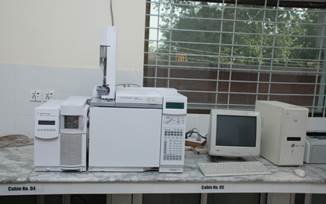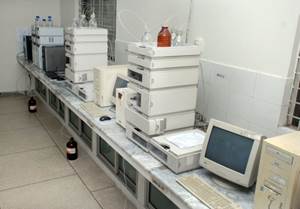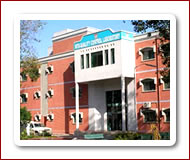Toxicology Section
 Toxicology section is equipped with the modern and sophisticated instruments like HPLC, GC, LC/MS, GC/MS, Amino acid analyzer and FTIR which are extensively used for the quantification of mycotoxins, pesticide residues and drug residues in food and feed samples. Toxicology section is equipped with the modern and sophisticated instruments like HPLC, GC, LC/MS, GC/MS, Amino acid analyzer and FTIR which are extensively used for the quantification of mycotoxins, pesticide residues and drug residues in food and feed samples.
Objectives
Provide facility for:
- Mycotoxin detection in Food/feed
- Drug residue testing
- Pesticide estimation
- Quantification of Pharmaceutical drugs in body fluid
Mycotoxins (Aflatoxin & Ochratoxin) are being analyzed in different food items (corn, rice, wheat, cereals & nuts) and animal feed by High Performance Liquid Chromatography. Aflatoxins are secondary metabolites of the molds Aspergillus flavus and Aspergillus parasiticus.  They are highly toxic, mutagenic, teratogenic and carcinogenic compounds found to contaminate a wide variety of important agricultural products. Aflatoxin B1 is the most abundant aflatoxin in naturally contaminated foods and feeds, especially in tropical and warm regions. Under FDA regulations, most food and feed ingredients are restricted to ≤20 µg/kg for total aflatoxin. Aflatoxin B1 ingested in contaminated feeds is absorbed in the gastrointestinal tract and mainly metabolized in the liver into aflatoxin M1, a metabolite as toxic as the parent mycotoxin that is excreted in urine and in milk of dairy animals. Presence of aflatoxin M1 in milk and dairy products may have negative health implications for consumers, particularly for infants and children. For this reason, AFM1 level in milk and milk products are regulated in many countries. The European Union fixed at 50 ng/L the limit of AFM1 in milk. They are highly toxic, mutagenic, teratogenic and carcinogenic compounds found to contaminate a wide variety of important agricultural products. Aflatoxin B1 is the most abundant aflatoxin in naturally contaminated foods and feeds, especially in tropical and warm regions. Under FDA regulations, most food and feed ingredients are restricted to ≤20 µg/kg for total aflatoxin. Aflatoxin B1 ingested in contaminated feeds is absorbed in the gastrointestinal tract and mainly metabolized in the liver into aflatoxin M1, a metabolite as toxic as the parent mycotoxin that is excreted in urine and in milk of dairy animals. Presence of aflatoxin M1 in milk and dairy products may have negative health implications for consumers, particularly for infants and children. For this reason, AFM1 level in milk and milk products are regulated in many countries. The European Union fixed at 50 ng/L the limit of AFM1 in milk.
 Pesticides are used on a large scale for agricultural purposes, and their adverse effects on both human health and the environment are a matter of public concern. Pesticide detection in food, soil, water and milk is also being performed in Toxicology section by HPLC and GC. Drug residues in milk, meat and eggs are also a major issue in Pakistan. Different drug residues can be analysed by HPLC in Toxicology section. Beside these, the toxicology lab. is also capable to detect the organic acids, phenolic acids, flavonols, vitamins and fatty acids in different food/feed. Pesticides are used on a large scale for agricultural purposes, and their adverse effects on both human health and the environment are a matter of public concern. Pesticide detection in food, soil, water and milk is also being performed in Toxicology section by HPLC and GC. Drug residues in milk, meat and eggs are also a major issue in Pakistan. Different drug residues can be analysed by HPLC in Toxicology section. Beside these, the toxicology lab. is also capable to detect the organic acids, phenolic acids, flavonols, vitamins and fatty acids in different food/feed.
Test Offers:
Test Items |
Methods |
Price (Rs.) |
Mycotoxin |
Aflatoxin (B1, B2, G1 & G2) |
HPLC |
6000/- |
Aflatoxin M1 |
HPLC |
6000/- |
Ochratoxin A |
HPLC |
6000/- |
Aflatoxin (B1, B2, G1 & G2) |
TLC |
3500/- |
Ochratoxin A |
TLC |
3500/- |
Residues of Veterinary Drugs |
Beta-Lactams |
HPLC |
6000/- |
Chloramphenicol |
HPLC |
6000/- |
Fluoroquinolones |
HPLC |
6000/- |
Sulfonamides |
HPLC |
6000/- |
Tetracyclines |
HPLC |
6000/- |
Pesticides |
Organochlorines |
HPLC/GC |
6000/- |
Organophosphates |
HPLC/GC |
6000/- |
Pyrethroids |
HPLC/GC |
6000/- |
Food Composition and Nutrition |
Amino Acids |
TLC |
3500/- |
Flavonols |
HPLC |
6000/- |
Organic acids |
HPLC |
6000/- |
Phenolic acids |
HPLC |
6000/- |
Vitamins |
HPLC |
6000/- |
|
